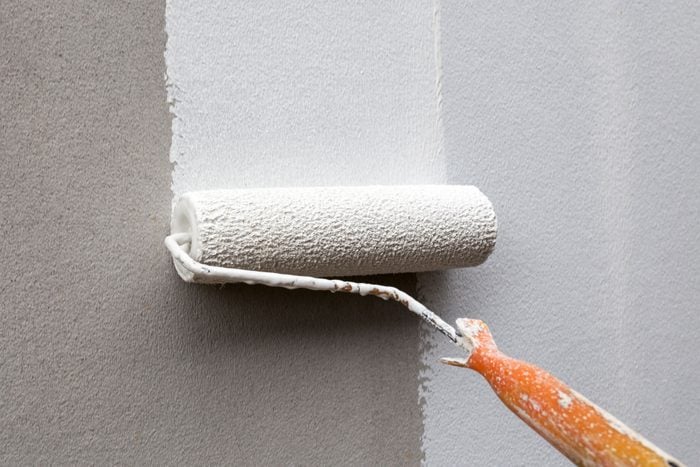Eggshell vs. Satin Paint: What’s the Difference?
Updated: Jan. 25, 2024

Ready to tackle your next paint project? Learn all about two of the most popular paint sheens.
When choosing paint colors for a room, don’t forget to consider the sheen, i.e. the level of shininess in a paint finish. Sheen can affect the paint’s appearance, durability and washability.
Sheen categories, from shiniest to dullest, are gloss, semi-gloss, satin, eggshell, matte and flat. “Think of sheen as a spectrum that goes from glossy to flat,” says Bill Carroll of Indiana University. “Imagine the difference between a mirror and sandpaper. That’s the difference between glossy and flat paint finishes.”
In this story, Carroll, Doug Curving from Sherwin-Williams and Zachariah Vaughn from Grace Paint and Tile provide helpful insight for the next time you’re deciding between eggshell and satin paint.
On This Page
What Is Eggshell Paint?
Eggshell is an interior paint product with a sheen that falls between flat and satin. The name derives from its slightly pebbled finish that resembles an eggshell. It’s well-loved for its velvety, slightly reflective look on wall surfaces.
What is eggshell paint good for?
“Eggshell is primarily the sheen of choice for bedroom, living room, hallway and entryway walls,” Vaughan says. If you prefer a sheen that cleans up well and doesn’t reflect much light, eggshell is the best choice.
Eggshell paint isn’t ideal for trim and woodwork, because its finish is not as durable or washable as a glossier paint. It’s also not recommended for high-humidity environments like bathrooms and kitchens.
Does eggshell paint need two coats?
“Ideally all painted surfaces should receive two coats unless expressly directed by the manufacturer,” Vaughan says. However, if you’re repainting walls the same color, one coat could be sufficient.
Should you use a roller or brush for eggshell paint?
Either is fine. Use a roller for large, open surfaces and a brush for wall edges and tight spaces.
Pros and cons of eggshell paint
Eggshell looks great on walls, hides some imperfections and leaves a smooth, velvety finish that can be washed. On the other hand, it does not hold up to scrubbing as well as satin paint and is not as durable.
What Is Satin Paint?
Satin paint is an interior or exterior paint product with a slightly higher sheen than eggshell but less than semi-gloss. When dry, satin paint resembles actual satin fabric, with its luminous and subtle glow. A versatile finish, satin paint can be used on walls and woodwork.
What is satin paint good for?
“Satin tends to be used more on kitchen and bathroom walls,” Curving says. Its smooth finish prevents moisture from saturating into the paint pigment, as it would with a flat or eggshell paint. “Sheen matters, especially in a moist environment like a bathroom,” he says.
Satin paint is washable as well. “Use glossy paints, including satin, in areas that are going to require a lot of cleaning,” Carroll says.
It’s also great on front doors, decorative trim or crown molding. “Satin paint on the trim really stands out, especially against an eggshell wall,” Vaughan says.
When should you use satin paint?
Satin paint performs well on kitchen and bathroom walls as well as woodwork like trim and cabinets. It’s also great for high-traffic areas that get dirty, like mudrooms or kids’ bedrooms. “I use it on walls where I need good washability,” Vaughan says.
What’s the best way to apply satin paint?
With a brush or roller, depending on the surface.
For walls, use a roller for open areas and a brush for detailed work like edging and corners. For a smoother finish when applying with a roller, Curving recommends using a short nap of 1/4- or 3/8-inch. “This will reduce the orange peel or dimpled look caused by the roller,” he says.
Pros and cons of satin paint
Satin paint’s washability and moisture tolerance are some of its best qualities. Depending on your style preference, the higher light reflectivity can be a pro or a con.
A downside? “Satin will highlight any uneven or rough aspects of a wall,” Vaughan says. It’s best to use on new construction or really smooth walls.
What’s the Better Paint Finish for Interior Walls?
It depends. Eggshell is great on less than perfect walls in low-humidity environments with medium washability requirements. Satin is the best for moisture-prone areas like bathrooms or rooms that need frequent washing, like a child’s bedroom.
Which Paint Sheen Hides Imperfections Better?
“Eggshell is the slightly less shiny of the two, so it’s going to not highlight imperfections as much,” Curving says.
Is Eggshell or Satin Easier to Clean?
Satin, due to its shiny, smooth surface. “The shinier the finish, the less likely dirt, humidity and moisture can get embedded into the surface of the paint,” Curving says, “which improves its washability.”
About the Experts
Bill Carroll, Ph.D., is an adjunct professor of chemistry at Indiana University. The former vice president of industry issues for Occidental Chemical Corporation, he’s currently principal of Carroll Applied Science in Dallas, Texas.
Doug Curving is a sales service representative for Sherwin-Williams with Lowe’s business unit. He has more than 20 years in the paint industry.
Zachariah Vaughan, owner of Grace Paint and Tile in Florence, Massachusetts, has 30 years of experience in the paint and tile industry.
